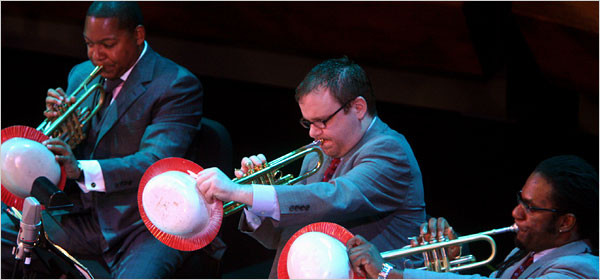Jazz Master’s Signature, Written in Sax and Brass

(photo: Hiroyuki Ito for The New York Times)
Benny Carter spread his aesthetic throughout jazz from the 1920s to the 1960s, and he did it in a number of ways. Jazz exists first in the public imagination through its soloist stars, and from the mid-’20s onward Carter was a great improviser — first on alto saxophone, then on trumpet — though he didn’t satisfy anyone’s picture of a jazz genius as a troubled, mercurial man-child; he was private and professional.
But he was also an excellent composer, arranger and bandleader, able to handle great quantities of music and musicians; he knew how to collaborate. Those qualities eventually took him around the world and gave him longevity, so that he made excellent music until his death in 2003 at 95.
It was fitting then that no single musician ran away with Jazz at Lincoln Center’s Friday night concert at Rose Theater, based around Carter’s music, this year’s season-opening program. (Carter was born in 1907, and this is his centennial year.) If there was a star, it was a whole bloc within a band: the Jazz at Lincoln Center Orchestra’s saxophone section, playing the tightly harmonized passages that were among Carter’s signatures.
Carter’s arrangement of “All of Me,” from 1940, is a good example. After an introduction, it began with the four saxophonists playing two choruses of harmonized lockstep, running a rewritten version of the melody through the chords, and it had everything an individual solo can have: melodic shape, hesitation, easy swing, double-timing, open space. The same thing happened again, at the same level of execution, in “I Can’t Escape From You.” It was demanding music, beautifully coordinated.
The show’s first half drew from 78 r.p.m. records, and the songs were over after a few blinks. Even with the introduction of a few singers (Cynthia Scott on “When Lights Are Low” and the orchestra’s trombonist, Vincent Gardner, singing the ersatz cowboy lyrics in “Cow Cow Boogie”), most of them reflected the compression of the recordings. They made their point, as quiet glides or rubbery riff tunes or saxophone-section bonanzas, then vanished.
The second section of the concert opened the music up a little more. “Doozy,” a stylish Carter blues from his 1961 record “Further Definitions,” is three and a half minutes on the recording; on Friday it ran longer, and deservedly so. They cracked it open. Bob Wilber appeared as a guest soloist and, in the middle of the tune, traded solos on sopranino saxophone with the baritone saxophonist Joe Temperley, little horn against big horn. Then the focus shifted to the alto saxophonists Ted Nash and Sherman Irby, Mr. Nash playing aggressive interval-jumps, Mr. Irby contradicting him with more gentle and congenial phrases.
Well, maybe there was a star, and maybe it was Mr. Irby. The alto saxophone was Carter’s instrument, and on three memorable solos Mr. Irby used his rich, plummy, rounded tone, one you almost never hear from younger saxophonists anymore, with a vibrato like a throb. The music deepened emotionally as it went along chronologically, and at the end — Carter’s slow, lovely final composition, “Again and Again,” from 2000 — the concert became an almost mystical kind of blue-light séance
by Ben Ratliff
Source: The New York Times
